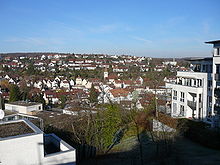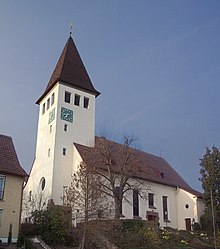
Stuttgart is the capital and largest city of the German state of Baden-Württemberg. It is located on the Neckar river in a fertile valley known as the Stuttgarter Kessel and lies an hour from the Swabian Jura and the Black Forest. Stuttgart has a population of 635,911, making it the sixth largest city in Germany, while over 2.8 million people live in the city's administrative region and nearly 5.5 million people in its metropolitan area, making it the fourth largest metropolitan area in Germany. The city and metropolitan area are consistently ranked among the top 4 European metropolitan areas by GDP; Mercer listed Stuttgart as 21st on its 2015 list of cities by quality of living; innovation agency 2thinknow ranked the city 24th globally out of 442 cities in its Innovation Cities Index; and the Globalization and World Cities Research Network ranked the city as a Beta-status global city in their 2020 survey. Stuttgart was one of the host cities for the official tournaments of the 1974 and 2006 FIFA World Cups.
Esslingen is a Landkreis (district) in the centre of Baden-Württemberg, Germany. Neighboring districts are Rems-Murr, Göppingen, Reutlingen, Böblingen and the district-free city Stuttgart.

Mühlacker is a town in the eastern part of the Enz district of Baden-Württemberg, Germany. Mühlacker station has direct rail connections with Stuttgart, Karlsruhe, Heidelberg, Pforzheim and the Northern Black Forest.

Böblingen is a town in Baden-Württemberg, Germany, seat of Böblingen District. Sindelfingen and Böblingen are contiguous.

Rainer Wieland is a German politician who has been serving as a member of the European Parliament for Germany since 1997. He is a member of the Christian Democratic Union, part of the European People's Party. He has been a member of the European Parliament since 1997 and one of its vice-presidents since 2009. His area of responsibility as a member of the European Parliament includes the Stuttgart administrative district. Since 2011, Wieland has been president of the non-partisan Europa-Union Deutschland.

Hohenheim is one of 18 outer quarters of the city of Stuttgart in the borough of Plieningen that sits on the Filder in central Baden-Württemberg. It was founded in 1782.

Vaihingen an der Enz is a town located between Stuttgart and Karlsruhe, in southern Germany, on the western periphery of the Stuttgart Region. Vaihingen is situated on the river Enz, and has a population of around 30,000. The former district-capital is now part of the district of Ludwigsburg in the Land (state) of Baden-Württemberg. It is 25 km northwest of Stuttgart, and 15 km west of Ludwigsburg. Not to be confused with Vaihingen, a district of Stuttgart.
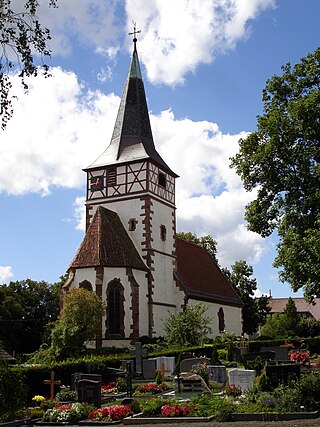
Ditzingen is a town in the district of Ludwigsburg, Baden-Württemberg, Germany. It is located approximately 10 km northwest of Stuttgart, and 12 km southwest of Ludwigsburg. The Hirschlanden transmitter was located near Ditzingen-Hirschlanden. Ditzingen is the home of Bürger GmbH, Reclam and also Trumpf GmbH.

Gerlingen is a town in the district of Ludwigsburg, Baden-Württemberg, Germany. It is situated 9 km west of Stuttgart, and 15 km southwest of Ludwigsburg. Gerlingen is home to Bosch, a major engineering and electronics company.

The Stuttgart Stadtbahn is a light rail system in Stuttgart, Germany. The Stadtbahn began service on 28 September 1985. It is operated by the Stuttgarter Straßenbahnen AG (SSB), which also operates the bus systems in that city. The Stuttgart Stadtbahn is successor system of a tram network (Straßenbahnen) that characterized the urban traffic in Stuttgart for decades.

Feuerbach is a borough of the city of Stuttgart. Its name is derived from the small river of the same name that flows from the neighboring district of Botnang through Feuerbach. Feuerbach is home to one of Germany's biggest industrial giants and is surrounded by the districts of Zuffenhausen, Bad Cannstatt, Stuttgart-North, Stuttgart-West, Botnang and Weilimdorf.

Weilimdorf, until 1955 known as "Weil im Dorf", is the north-western borough (Stadtbezirk) of the German city and capital of Baden-Württemberg, Stuttgart. Weilimdorf, covering an area of 12.6 square kilometres (4.9 sq mi) with a population of around 30,000, borders the Stadtbezirke of Zuffenhausen, Feuerbach, Stuttgart-West, and the towns of Gerlingen, Ditzingen, and Korntal-Münchingen in the Ludwigsburg district. Weilimdorf became part of Stuttgart in 1933 amidst the hardship of the economic instability of the 30s in Germany. The city district is made up by six Stadtteile: Weilimdorf, Bergheim, Giebel, Hausen, Weilimdorf-Nord and Wolfbusch and is home to an expanding commercial area.

The Western Railway in Württemberg was opened in 1853 and ran from Bietigheim-Bissingen to Bruchsal. It was the first railway link between the states of Württemberg and Baden in Germany and one of the oldest lines in Germany.

Stuttgart-Weilimdorf station is in the Stuttgart municipality of Weilimdorf in the German state of Baden-Württemberg on the Württemberg Black Forest railway and is part of the Stuttgart S-Bahn network.
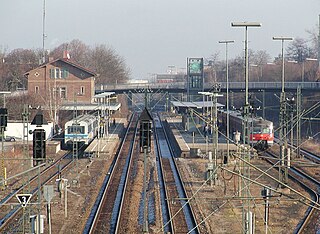
Korntal station is in the town of Korntal-Münchingen in the German state of Baden-Württemberg. It is on the Württemberg Black Forest railway, which is served by the Stuttgart S-Bahn network. It is the starting point of the Strohgäu Railway, which is served by the Württembergische Eisenbahn-Gesellschaft.

Stuttgart North station is a railway station in Stuttgart, Germany, serving the North area of the city. It consists of a passenger railway station on the Stuttgart S-Bahn and a goods yard.

Leinfelden station is located in Leinfelden-Echterdingen at the 20.6 kilometre point of the Stuttgart-Rohr–Filderstadt railway in the German state of Baden-Württemberg and is a station on the Stuttgart S-Bahn network.
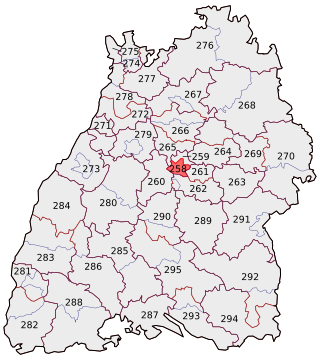
Stuttgart I is an electoral constituency represented in the Bundestag. It elects one member via first-past-the-post voting. Under the current constituency numbering system, it is designated as constituency 258. It is located in central Baden-Württemberg, comprising the central and southern part of the city of Stuttgart.
The following is a timeline of the history of the city of Stuttgart, Germany.

Plieningen is the southernmost borough (Stadtbezirk) of Stuttgart in the state of Baden-Württemberg. Plieningen is located about 10 kilometres (6.2 mi) from the city center of Stuttgart on the Filder Plain. Schloss Hohenheim, part of the Stuttgart Airport, and the parking garage for the Stuttgart Trade Fair are located here.




